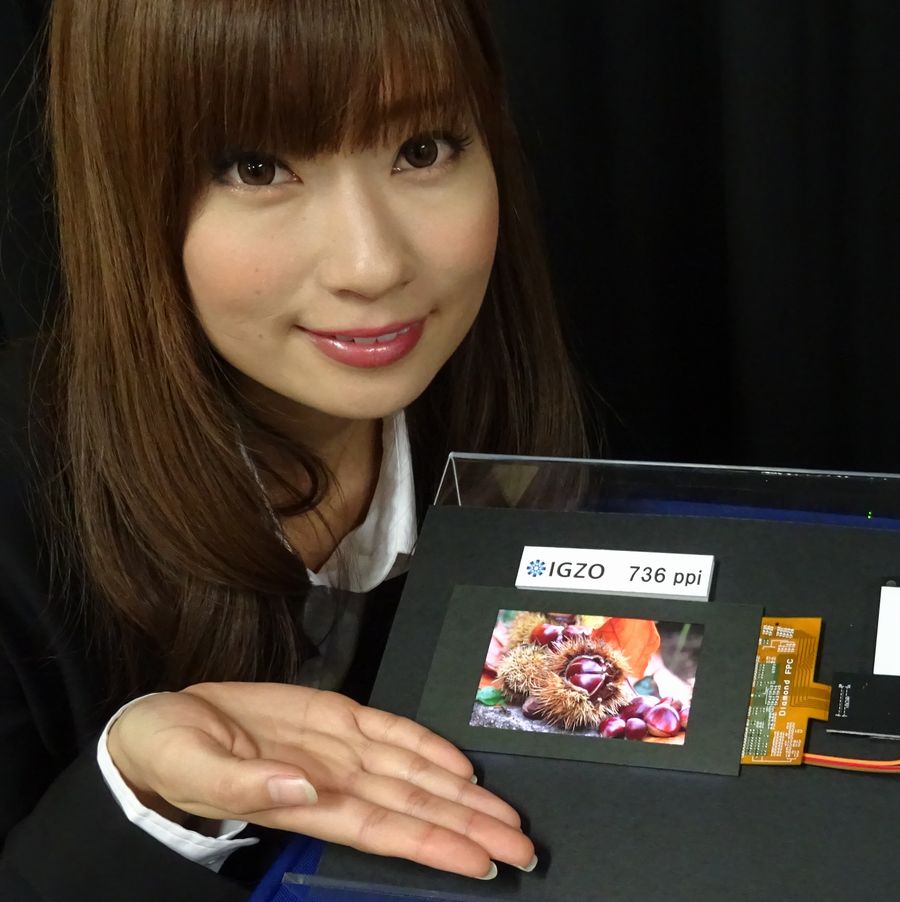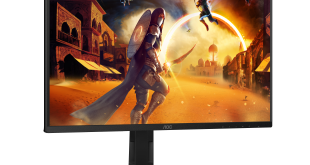Sharp Corp. this week demonstrated the world’s first display with incredible 736 pixels per inch (ppi) pixel density. The company said that it will be able to commercially ship such display panels in calendar 2016.
The experimental 4.1” panel from Sharp has resolution of 2560*1600 (WQXGA), which is not a breakthrough for mobile devices nowadays. Nonetheless, the pixel density of 736 pixels per inch is considerably higher than the record pixel density of today’s top smartphones from LG and Samsung (which feature pixel density of around 500ppi). The panel with record pixel density is based on Sharp’s IGZO technology.
Keeping in mind that a human’s eye cannot see individual pixels on screens with 350ppi – 400ppi density at typical smartphone viewing distances, it is unclear whether Sharp’s 4.1” 2560*1600 display will find any practical use. Nonetheless, ultimate pixel density of 736 pixels per inch opens doors to mainstream-sized smartphones with 4K (3840*2160) ultra-high-definition screens.

Image by Sharp. Published by Nikkei.
Sharp said that it would be able to commercially ship displays with such pixel density only in fiscal 2016 (starts on the 1st of April, 2016), therefore, the technology is not quite ready for mass production yet.
Incredible pixel density will not only open doors to smartphones with 4K displays, but will also enable companies like Sharp to create screens with even higher resolutions. In fact, in order to build 8K (7680*4320) TVs and displays several years down the road, Sharp and other manufacturers will need to learn how to produce panels with increased pixel density cost-efficiently.
Discuss on our Facebook page, HERE.
KitGuru Says: While many researchers say that there is a limit in human’s ability to percept individual pixels at certain pixel density (and viewing densities), it looks like display makers continue to push the PPI upwards. While generally it is not bad, keep in mind that high resolutions mean increased power consumption and increased demand for graphics processing horsepower (which means increased power consumption too). At some point certain technical advantages cease to bring real benefits, but continue to increase requirements…
 KitGuru KitGuru.net – Tech News | Hardware News | Hardware Reviews | IOS | Mobile | Gaming | Graphics Cards
KitGuru KitGuru.net – Tech News | Hardware News | Hardware Reviews | IOS | Mobile | Gaming | Graphics Cards



Great . .Its hard to tell the difference between 720p from 1080p . how much more if 4k?
I can understand that with the pixel density of phones and tablets 4k seems a little ridiculous, because of the size of the screen even 720p is usually more than enough but I guess this can be a good thing. If 4k resolutions are achieved then more experiments into extending the life of lithium ion batteries or finding a suitable replacement will come into play, then manufacturers can backtrack to 720p/1080p with really good battery life
Just to point out that 4K and UHD are different resolutions. “4K has become the common name for ultra high definition television (UHDTV), although its resolution is only 3840 x 2160 (at a 16:9, or 1.78:1 aspect ratio), which is lower than the 4K industry standard of 4096 x 2160 (at a 19:10 or 1.9:1 aspect ratio).” Source: http://en.m.wikipedia.org/wiki/4K_resolution
You’re kidding right? O.o 720p and 1080p are worlds apart.
Depends on the distance between you and the screen and the the size of the screen of course. There won’t be much difference looking at 4′ with 720p or 1080p, you can notice some on 5′ and it gets more noticable as the screen size goes up. So 1080p is good for mobile phones/phablets, 1440p is good for phablets/tablets. 4K maybe for those 10′ tablets.
Technically you’re right but Ultra HD is just the classification for 4K resolution, like HD is 720p and True HD is 1080p. If manufacturers can’t get it right then it’s their problem but hey if we want to spark off a new classification such as True Ultra HD for the real 4K reoslution then fuck it why not xD
haha 4k on phones, or even tabs is too much. .we should put more effort on battery efficiency rather than ppi . .1080p is enough (for me) . .
Well not really.. UHD is the 16:9 version (with a slightly lower res) of 4K. True 4K is actually 19:10 but no content uses that ratio. Best way to remember it, if a manufacturer says 4K, they really mean UHD!
Edit: Using your examples for mine: HD -> FHD -> UHD 🙂 To use the industry standards: 2K -> 4K (not sure what HD (720) is)
This is awesome news for close to eye devices such as the Oculus Rift